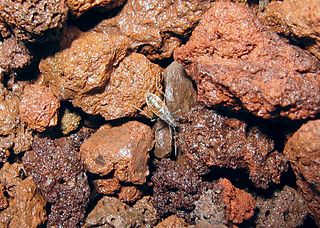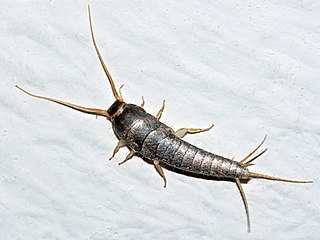
Onychophora, commonly known as velvet worms or more ambiguously as peripatus, is a phylum of elongate, soft-bodied, many-legged panarthropods. In appearance they have variously been compared to worms with legs, caterpillars, and slugs. They prey upon other invertebrates, which they catch by ejecting an adhesive slime. Approximately 200 species of velvet worms have been described, although the true number of species is likely greater. The two extant families of velvet worms are Peripatidae and Peripatopsidae. They show a peculiar distribution, with the peripatids being predominantly equatorial and tropical, while the peripatopsids are all found south of the equator. It is the only phylum within Animalia that is wholly endemic to terrestrial environments, at least among extant members. Velvet worms are generally considered close relatives of the Arthropoda and Tardigrada, with which they form the proposed taxon Panarthropoda. This makes them of palaeontological interest, as they can help reconstruct the ancestral arthropod. Only two fossil species are confidently assigned to as onychophorans: Antennipatus from the Late Carboniferous, and Cretoperipatus from the Late Cretaceous, the latter belonging to Peripatidae. In modern zoology, they are particularly renowned for their curious mating behaviours and the bearing of live young in some species.

Punaluʻu Beach is a beach between Pāhala and Nāʻālehu on the Big Island of the U.S. state of Hawaii. The beach has black sand made of basalt and created by lava flowing into the ocean which explodes as it reaches the ocean and cools. This volcanic activity is in the Hawaiʻi Volcanoes National Park. Punaluʻu is frequented by endangered hawksbill and green turtles, which can often be seen basking on the black sand.

Kazumura Cave is a lava tube and has been surveyed at 40.7 miles long and 3,614 feet deep making it the longest and deepest lava tube in the world. The cave is located on the island of Hawaiʻi on the eastern slope of Kīlauea. Kīlauea is the most recently active volcano on the Big Island. The ʻAilāʻau lava flow that contains Kazumura Cave originated from the Kīlauea Iki Crater about 500 years ago.

Troglofauna are small cave-dwelling animals that have adapted to their dark surroundings. Troglofauna and stygofauna are the two types of subterranean fauna. Both are associated with subterranean environments – troglofauna are associated with caves and spaces above the water table and stygofauna with water. Troglofaunal species include spiders, insects, myriapods and others. Some troglofauna live permanently underground and cannot survive outside the cave environment. Troglofauna adaptations and characteristics include a heightened sense of hearing, touch and smell. Loss of under-used senses is apparent in the lack of pigmentation as well as eyesight in most troglofauna. Troglofauna insects may exhibit a lack of wings and longer appendages.

Nysius wekiuicola is a species of wēkiu bug endemic to the area surrounding the summit of Mauna Kea, on the island of Hawaiʻi. It is closely related to Nysius aa, which is endemic to the summit of the neighboring Mauna Loa.

Phidippus audax, the bold jumper or bold jumping spider, is a common species of spider belonging to the genus Phidippus, a group of jumping spiders easily identified by their large eyes and their iridescent chelicerae. Like all jumping spiders, they have excellent stereoscopic vision that aids them in stalking prey and facilitates visual communication with potential mates during courting. Bold jumping spiders are native to North America and have been introduced to Hawaii, Nicobar Islands, Azores, and the Netherlands. They are typically black with a distinct white triangle on their abdomen.

The Kauaʻi cave wolf spider, also known to local residents as the blind spider, is only known to occur in a few caves in a lava flow with an area of 10.5 km2 (4.1 sq mi) in the Kōloa–Poʻipū region of Kauaʻi, Hawaiian Islands, and only six populations are known to exist. While their nearest surface-dwelling relatives have large eyes, this species has completely lost its eyes. They reach a body length around 20 mm (0.8 in), and are reddish brown and completely harmless to people. Unlike most wolf spiders, it produces only 15 to 30 eggs per clutch. The female carries the egg sac in her mouthparts until the spiderlings hatch.
Cave-dwelling insects are among the most widespread and prominent troglofauna, including troglobites, troglophiles, and trogloxenes. As a category of ecological adaptations, such insects are significant in many senses, ecological, evolutionary, and physiological.

The São Tomé leaf-nosed bat is a species of bat in the family Hipposideridae. It is endemic to the island of São Tomé, in the Gulf of Guinea off the western coast of Africa. The bat's natural habitats are subtropical or tropical moist lowland forests and caves.
Caconemobius is a genus of crickets in the subfamily Nemobiinae. There are about 15 species distributed from the Pacific coasts of Asia to Hawaii, where they occur in marine environments on the shores of the Pacific Ocean, barren lava fields, and lava tube caves.

Caconemobius varius is a species of cricket known by the common name Kaumana cave cricket. It is endemic to the island of Hawai'i, where it inhabits the dark zone of lava tube caves.

The silverfish is a species of small, primitive, wingless insect in the order Zygentoma. Its common name derives from the insect's silvery light grey colour, combined with the fish-like appearance of its movements. The scientific name indicates that the silverfish's diet consists of carbohydrates such as sugar or starches. While the common name silverfish is used throughout the global literature to refer to various species of Zygentoma, the Entomological Society of America restricts use of the term solely for Lepisma saccharinum.

Water treaders, the superfamily Mesovelioidea, are insects in the order Hemiptera, the true bugs. They are semiaquatic insects that live in moist and wet habitat and on wet plant matter in several types of aquatic habitat.
Schrankia howarthi is a species of moth of the family Erebidae. It normally occurs within the twilight to dark zone areas of lava tubes on the islands of Maui and Hawaii, however, it is sometimes found flying on the surface of both islands. The paler morph may be restricted to the dark zone of lava tubes.

Subterranean fauna refers to animal species that are adapted to live in an underground environment. Troglofauna and stygofauna are the two types of subterranean fauna. Both are associated with hypogeal habitats – troglofauna is associated with terrestrial subterranean environment, and stygofauna with all kind of subterranean waters.
Synemporion keana is an extinct species of bat which lived in what is now Hawaii from at least 320,000 years ago to around 2,100 years ago. It is the only species in the genus Synemporion.

Mesoveliidae is a family of water treaders in the order Hemiptera. There are about 16 genera and at least 50 described species in Mesoveliidae.
An anchialine system is a landlocked body of water with a subterranean connection to the ocean. Depending on its formation, these systems can exist in one of two primary forms: pools or caves. The primary differentiating characteristics between pools and caves is the availability of light; cave systems are generally aphotic while pools are euphotic. The difference in light availability has a large influence on the biology of a given system. Anchialine systems are a feature of coastal aquifers which are density stratified, with water near the surface being fresh or brackish, and saline water intruding from the coast at depth. Depending on the site, it is sometimes possible to access the deeper saline water directly in the anchialine pool, or sometimes it may be accessible by cave diving.

Oliarus polyphemus, the Hawai'i cave planthopper, is a species of Oliarus planthopper endemic to the island of Hawai'i, where it inhabits lava tubes and crevice networks embedded in solidified lava flows.
Oliarus kalaupapae, the Moloka'i cave planthopper, is a species of Oliarus planthopper endemic to the island of Moloka'i, where it inhabits lava tubes.














